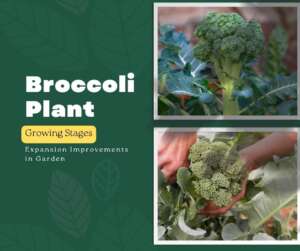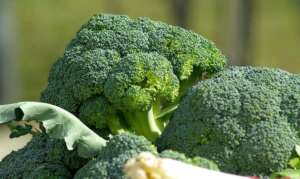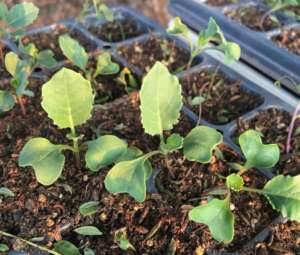Table of Contents
Broccoli is from the cabbage family. We want to share information about “Broccoli plant growing stages” with you to spread awareness about the best crop results.
 Broccoli Plant growing stages: Greatest Secret in Gardening
Broccoli Plant growing stages: Greatest Secret in Gardening
Now you can grow The Broccoli plant more quickly than ever before.
This must be the Greatest Secret in Gardening because it goes through several growth stages during its lifetime. The plant starts as a seed in the soil, and by the passage of time, it will grow into a mature vegetable. Each step of growth presents different challenges and opportunities for the plant. Understanding these stages is important for farmers and house gardeners who want to get the most out of their crops.
Nutritional fact
Broccoli is an excellent source of Vitamin C, Folate, and Potassium. It’s also loaded with Phytonutrients, including Sulforaphane, which may help prevent cancer. The best part of Broccoli is that it is easy to grow and can be harvested in as little as 60 days from planting.
Types of Broccoli Seeds
There are two types of Broccoli seeds:
- Hybrid seeds
- Organic seeds
Instructions to follow before buying Broccoli Growing Plant Seeds
While purchasing seeds, you must flip the package over and see how long it takes to grow Broccoli.
-
Cautions while purchasing seeds
“Ready-to-harvest” seeds are not ideal for growing broccoli because they may not give you enough time to get a good-sized plant before they bolt (flower).
Instead, look for seeds that take longer than three months to mature. The best time is between six to eight months to let your plants grow without worrying about them bolting before they’re ready to harvest.
Easy steps to grow delicious Broccoli
The broccoli plant grows best in cool weather, so it is a good crop to plant in the spring or fall. It will grow well in most climates and can be grown in the ground or containers. You may increase the growth rate by following the nine steps we are undergoing.
Step : Fertile spot and temperature
Plant broccoli seeds in early spring or fall, when the soil is still cool enough for germination but warm enough to keep the plant growing through winter. Choose an area that gets at least six hours of sunlight daily. The soil should be well-drained but not too sandy or rocky.
Broccoli plants need temperatures between 65 F (18 C) and 75 F (24 C). It will do best to plant your broccoli near a fence or wall to protect it from cold winds. To keep it from being too exposed to the elements, you may want to plant it in a raised bed filled with compost or other organic material. However, if you don’t have one available, give the broccoli plenty of room and let it grow as big as possible before harvesting. For example, broccoli plants can grow up to 4 to 6 feet tall.
Step : Preparing the soil
Broccoli needs fertile soil with plenty of nitrogen, so add compost or fertiliser before planting if required. Make sure your chosen area has been well prepared before planting by digging it up to 8 inches deep. It would be best to prepare your garden bed by removing weeds or debris. This will help ensure that your plants get everything they need while growing to produce large heads later. If your soil is particularly sandy or of poor quality, consider adding some compost. This contains nutrients otherwise lacking in sandy soils, such as nitrogen and potassium (which help produce healthy roots).
Step : Sowing
Sow one or two seeds every inch (2.5 cm) in rows spaced 18 inches (46 cm) apart from each other and 1 inch (2.5 cm) deep into prepared soil; cover lightly with soil and water thoroughly after sowing seeds to germinate them faster.
Step : Choose a large-headed variety to grow the best nutrient broccoli

Select a large-headed type to produce the best nutrient broccoli. The most common types are:
‘Waltham’
‘DeCicco’
‘Arcadia’
‘Green Goliath’
Plant these varieties in rich soil with plenty of organic matter, such as compost or well-rotted manure.
Step : Plant Broccoli seeds in spacious rows
Space plants 18 inches apart with rows 24 inches apart so you can reach between them easily to harvest the heads of broccoli when they’re ready for picking.
Step : How to water after sowing Broccoli seeds

Water deeply once a week, so the soil becomes moist 4 inches down from the surface of the ground around each plant until it’s ready to harvest about 65 days after germination if you’re starting indoors or 90 days if you’re starting seeds directly into your garden bed after all danger of frost, has passed.
Step : Pluck your seedlings
Pluck your seedlings for the best results. When you plant broccoli seeds, some will germinate faster than others, so you’ll need to thin out some of these seedlings, so they don’t compete for nutrients and sunlight. Trim away the weaker seedlings or pull them out by hand once they’ve sprouted leaves about an inch long.
Step : Harvest Broccoli Plant
Broccoli is an easy vegetable to grow, but you have to harvest it at the right time. It will be bitter and inedible if you harvest broccoli too early or too late. The best time to harvest broccoli is when the flower buds are still tightly closed and before they open up into flowers.
-
Steps to follow for harvesting your Broccoli Plant
- Cut off the flower stems.
- Cut off any remaining leaves and shrubs from around the base of each plant
- Step 9: Storing Broccoli Plant while growing
Broccoli can be stored in the refrigerator for up to 10 days uncovered with plenty of ventilation. By following this tip, you may keep it without spoiling premature broccoli and use it in cooking recipes and salad.
Final words
This article provides an overview of the broccoli plant’s growing stages. It includes information on when to plant and harvest the crop and tips on successfully growing broccoli. If you’re interested in increasing your broccoli, this is a great resource to consult.
